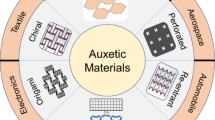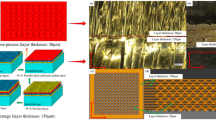Abstract
Selective laser sintering (SLS) is an additive manufacturing process, which has become popular for the production of full functional end-user parts as well as prototypes. Presently, many sectors particularly aerospace, automotive and biomedical are using 3D solid models (prototypes) for visualization, kinematic testing or to fulfil other functional demands. Therefore, SLS parts should have good surface quality (i.e. surface roughness) to fulfil the demands of these sectors. Surface roughness of the SLS fabricated parts relies on the various input process parameters. Hence, this study investigates the influence of key contributing factors (i.e. bed temperature, laser power, scan speed, scan spacing and scan length) on the surface roughness of glass-filled polyamide parts. Five factors, three-level, and face-centred central composite design of experiment were used to collect data, and response surface methodology was employed to investigate the effects and interactions of selected input process parameters. It has been found that scan spacing followed by laser power is the most significant factor, which contributes the most to improve surface roughness. Furthermore, the optimum values of different parameters were obtained and verified by conducting confirmation experiments.

Similar content being viewed by others
References
Cheah C.M., Chua C.K., Lee C.W., Feng C., Totong K.: Rapid prototyping and tooling techniques: a review of applications for rapid investment casting. Int. J. Adv. Manuf. Technol. 25(3–4), 308–320 (2005)
Negi, S.; Dhiman, S.; Sharma, R.K.: Basics and applications of rapid prototyping medical models. Rapid Prototyp. J. 20(3), 256–267 (2014)
Campbell I., Bourell D., Gibson I.: Additive manufacturing: rapid prototyping comes of age. Rapid Prototyp. J. 18(4), 255–258 (2012)
ASTM International: standard terminology for additive manufacturing technologies: F2792-12a. US (2012)
Goodridge R.D., Shofner M.L., Hague R.J.M., Mcclelland M., Schlea M.R., Johnson R.B., Tuck C.J.: Processing of a polyamide-12/carbon nano fibre composite by laser sintering. Polym. Test. 30(1), 94–100 (2011)
Mazzoli A., Moriconi G., Pauri M.G.: Characterization of an aluminum-filled polyamide powder for applications in selective laser sintering. Mater. Des. 28(3), 993–1000 (2007)
Dotchev K., Yusoff W.: Recycling of polyamide 12 based powders in the laser sintering process. Rapid Prototyp. J. 15(3), 192–203 (2009)
Calignano F., Manfredi D., Ambrosio E.P., Iuliano L., Fino P.: Influence of process parameters on surface roughness of aluminum parts produced by DMLS. Int. J. Adv. Manuf. Technol. 67(9–12), 2743–2751 (2013)
Bacchewar P.B., Singhal S.K., Pandey P.M.: Statistical modelling and optimization of surface roughness in the selective laser sintering process. J. Eng. Manuf. 221(1), 35–52 (2007)
Su X., Yang Y., Xiao D., Luo Z.: An investigation into direct fabrication of fine structured components by selective laser melting. Int. J. Adv. Manuf. Technol. 64(9–12), 1231–1238 (2012)
Sachdeva A., Singh S., Sharma V.S.: Investigating surface roughness of parts produced by SLS process. Int. J. Adv. Manuf. Technol. 64(9–12), 1505–1516 (2012)
Yang Y., Fuh J.Y.H., Loh H.T., Wong Y.S.: Multi-orientational deposition to minimize support in the layered manufacturing process. J. Manuf. Syst. 22(2), 116–129 (2003)
Tang Y., Loh H.T., Wong Y.S., Fuh J.Y.H., Lu L., Wang X.: Direct laser sintering of a copper-based alloy for creating three-dimensional metal parts. J. Mater. Process. Technol. 140(1–3), 368–372 (2003)
Tumer I.Y., Thompson D.C., Wood K.L., Crawford R.H.: Characterization of surface fault patterns with application to a layered manufacturing process. J. Manuf. Syst. 17(1), 23–36 (1995)
Tang Y., Fuh J.Y.H., Loh H.T., Wong Y.S., Lu L.: Direct laser sintering of silica sand. Mater. Des. 24(8), 623–629 (2003)
Strano, G.; Hao, L.; Everson R.M.; Evans K.E.: Multi-objective optimization of selective laser sintering processes for surface quality and energy saving. J. Eng. Manuf. doi:10.1177/0954405411402925 (2011)
Ning Y., Song Y.S., Fuh J.Y.H.: Effect and control of hatch length on material properties in the direct metal laser sintering process. J. Eng. Manuf. 219(1), 15–25 (2005)
Wang Y., Bergstr J., Burman C.: Characterization of an iron-based laser sintered material. J. Mater. Process. Technol. 172(1), 77–87 (2006)
Rossi S., Deflorian F., Venturini F.: Improvement of surface finishing and corrosion resistance of prototypes produced by direct metal laser sintering. J. Mater. Process. Technol. 148(3), 301–309 (2004)
Song Y.A.K., Koenig W.: Experimental study of the basic process mechanism for direct selective laser sintering of low-melting metallic powder. CIRP Ann. Manuf. Technol. 46(1), 127–130 (1997)
Lonardo P.M., Bruzzone A.A.: Measurement and topography characterisation of surfaces produced by selective laser sintering. CIRP Ann. Manuf. Technol. 49(1), 427–430 (2000)
Masood S.H., Rattanawong W., Iovenitti P.: A generic algorithm for a best part orientation system for complex parts in rapid prototyping. J. Mater. Process. Technol. 139(1–3), 110–116 (2003)
Senthilkumaran K., Pandey P.M., Rao P.V.M.: Influence of building strategies on the accuracy of parts in selective laser sintering. Mater. Des. 30(8), 2946–2954 (2009)
Dupin S., Lame O., Barres C., Charmeau J.Y.: Microstructural origin of physical and mechanical properties of polyamide 12 processed by laser sintering. Eur. Polym. J. 48(9), 1611–1621 (2012)
Arumugam S., Sriram G., Rajmohan T.: Multi-response optimization of epoxidation process parameters of rapeseed oil using response surface methodology-based desirability analysis. Arab. J. Sci. Eng. 39, 2277–2287 (2014)
Matlob A.S., Kamarudin R.A., Jubri Z., Ramli Z.: Using the response surface methodology to optimize the extraction of silica and alumina from coal fly ash for the synthesis of Zeolite Na-A. Arab. J. Sci. Eng. 37, 27–40 (2012)
Niu H., Li Y., Lei Y., Zhang L., Peng J., Guo S.: Microwave drying of anthracite: a parameter optimized by response surface methodology. Arab. J. Sci. Eng. 37, 65–73 (2012)
Aldahdooh M.A.A., Bunnori N.M., Johari M.A.M.: Evaluation of ultra-high performance fiber reinforced concrete binder content using the response surface method. Mater. Des. 52, 957–965 (2013)
Acherjee B., Kuar A.S., Mitra S., Misra D.: Modeling and analysis of simultaneous laser transmission welding of polycarbonates using an FEM and RSM combined approach. Opt. Laser Technol. 44(4), 995–1006 (2012)
Balachandran M., Devanathan S., Muraleekrishnan R., Bhagawan S.S.: Optimizing properties of nanoclay-nitrile rubber (NBR) composites using face centred central composite design. Mater. Des. 35, 854–862 (2012)
Montgomery D.C.: Design and Analysis of Experiment. Wiley, NewYork (1997)
Mourabet, M.; Rhilassi, A.E.; Boujaady, H.E.; Ziatni, M.B.; Hamri, R.E.; Taitai, A.: Removal of fluoride from aqueous solution by adsorption on hydroxyapatite (HAp) using response surface methodology. J. Saudi Chem. Soc. doi:10.1016/j.jscs.2012.03.003 (2012)
Author information
Authors and Affiliations
Corresponding author
Rights and permissions
About this article
Cite this article
Negi, S., Dhiman, S. & Sharma, R.K. Investigating the Surface Roughness of SLS Fabricated Glass-Filled Polyamide Parts Using Response Surface Methodology. Arab J Sci Eng 39, 9161–9179 (2014). https://doi.org/10.1007/s13369-014-1434-7
Received:
Accepted:
Published:
Issue Date:
DOI: https://doi.org/10.1007/s13369-014-1434-7




